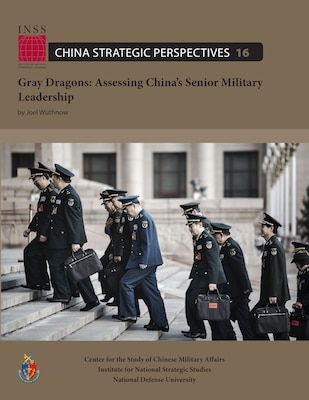Joel Wuthnow
Executive Summary

This report analyzes more than 300 biographies of senior Chinese military officers from 2015 and 2021 to assess the composition, demographics, and career patterns of the People’s Liberation Army (PLA) leadership. Key findings include the following points.The PLA is a conservative institution whose leaders waited their turn and achieved success in their services, and who have similar personal backgrounds.Average senior PLA officers rose patiently through the ranks over the course of careers spanning more than four decades; there were few opportunities for “fast burners” to achieve quicker success. Central Military Committee (CMC) Chairman Xi Jinping has not skipped over a generation of people who had waited their turn to promote young Turks more familiar with modern conflict.
The surest paths to success were in senior service positions. Joint experience was not common—the PLA has not implemented its own version of the U.S. Goldwater- Nichols Department of Defense Reorganization Act of 1986 mandate that officers become joint duty qualified.
Senior officers were homogenous in terms of age, education, gender, and ethnicity. Xi has not looked to a broader pool of talent to fill the senior ranks.
Leadership selections protect the institutional equities of different interest groups within the PLA.
There is a close correlation between service representation at the apex of the PLA hierarchy and manpower share in the PLA. No service is punching above or below its weight in China’s military leadership.Senior PLA leaders are drawn relatively equally from the 5 theater commands and 13 group armies. Even though it is responsible for Taiwan, the Eastern Theater Command cannot be described as a “cradle of the generals.” This system ensures that the interests of different parts of the PLA are represented at a high level.An increasing share of PLA officers are assigned to service headquarters, where they can be expected to lobby for their services’ interests and bureaucratic agendas.PLA reforms left the army in a dominant position but increased opportunities for navy, air force, and Rocket Force officers to become senior leaders.Xi oversaw a massive overhaul of the PLA that resulted in the army suffering a decline of about 20 percent of its end strength. That service saw its share of senior leaders cut by roughly the same percentage.
There have been some notable cases of non–PLA Army officers being appointed to senior positions, including theater commander and political commissar. Nevertheless, the army remains the dominant service in manpower and leadership representation. By contrast, the U.S. military has a more even service representation across key Joint Staff and combatant command assignments.PLA officers must continue to be responsive to Xi and the Chinese Communist Party.All PLA officers are members of the Chinese Communist Party and must have enough political acumen to demonstrate loyalty to Xi and his agenda.
Xi has been personally involved in selections through his position as CMC chairman and has increased his control through anti-corruption investigations. Also, officers are rotated geographically to prevent patronage networks.
The top 25 or so senior officers serve on the Chinese Communist Party Central Committee and in the National People’s Congress, where they provide military advice and look after PLA equities.Future PLA operations could be hampered by officers with narrow perspectives.Senior PLA officers tend to stay not only within their own services but also in their assigned functional areas. Operational commanders, for instance, rarely have career-broadening experience in logistics, and vice versa.
Relatively few officers in theater command positions have served in the CMC bureaucracy or in service headquarters.
Rigidity in PLA assignments could reduce China’s effectiveness in future conflicts— especially those requiring a high level of jointness and adaptability, like the war that Russia launched against Ukraine in 2022—if Chinese military leaders lack perspectives beyond their own service, specialty, and department.Some change is inevitable over the next decade, but the PLA will find it difficult to overturn traditions to promote a new model of PLA officer.The current cohort of PLA leadership is a transitional generation whose formative experiences were in the late Cold War period. Their successors will have “grown up” in the post–Cold War era when the PLA was more focused on regional contingencies.
Future leaders will have more experience with advanced technology and operational concepts. They may also be more confident in China’s capabilities and favor more risk-acceptant approaches to conflict.
Nevertheless, producing a fundamentally different type of senior PLA officer would require the kind of changes to service traditions and organizational culture that have proved difficult even for the United States more than three decades after Goldwater-Nichols.
No comments:
Post a Comment